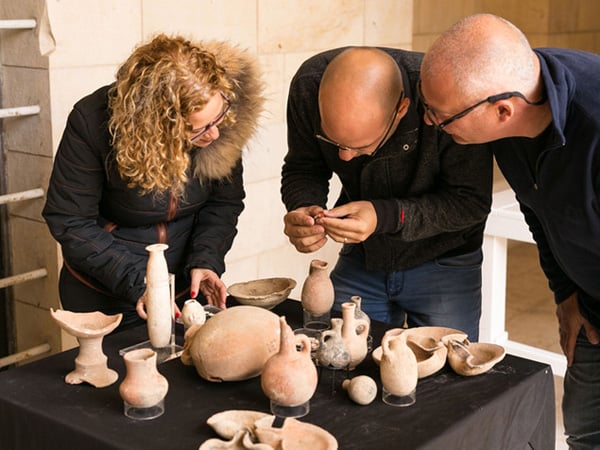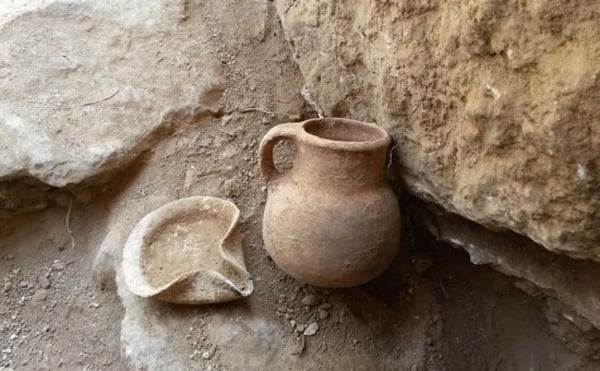Art World
Egyptian Artifacts Discovered in Israel Change Everything We Know About Passover
Egyptian culture was fashionable among Judean elites.

Photo: Mor Shauli via Walla
Egyptian culture was fashionable among Judean elites.

Hili Perlson

Israel is celebrating Passover to commemorate the liberation of Israelites from slavery and their exodus out of Egypt. But two sensational archeological finds made in Israel earlier this week show that Egyptians actually settled much farther north than once believed, in the Israeli Negev, and perhaps even as far north as Tel Aviv. (For more artnet News content about Jewish history, see Ancient iPad-like Tablets Reveal Life of Jews in Babylon and Museum Celebrates 1,000 Years of Poland’s Jewish History.)
In a press conference held in Jerusalem on Wednesday, the Israeli Antiquities Authority (IAA) presented 3,400-year-old artifacts found in the south of Israel, which evidence the existence of an Egyptian clerical post in the area during the Late Bronze Age and Early Iron Age, Kol Hazman report.
More than 300 ceramic artifacts were excavated from a cave in the Negev, most of them in astoundingly good condition. Archeologists also unearthed dozens of jewelry items made of bronze, shell, and Faience (a type of ceramic material), as well as unique stone tools made of yellowish alabaster, seal rings, and makeup flacons, all dating back to 1,500-1,000 BC.

Several items excavated in the south of Israel.
Photo: Clara Amit Courtesy IAA
According to standard biblical chronology, the exodus out of Egypt would have occurred at about 1,300 BC (although scholars are in dispute as to whether—and on what scale—the exodus did take place).
“The Israelites left Egypt, but it seems that even years after their exodus to Israel, Egypt did not leave the people of Israel and their descendants,” archeologist Amir Ganor, who headed the excavations, said. He added that this find gives “substantial evidence of the impact of Egyptian culture on the country’s Judean inhabitants.”
The discovery was made during an operation of the Unit for the Prevention of Antiquities Robbery, who noticed signs of looting in an underground cave. Inspectors found that antiquities thieves had broken into the cave, robbed some ancient pottery, and damaged the archeological strata. IAA officials excavated deeper in order to safeguard the ancient artifacts and precious archaeological information.
“Most of the scarab seals found in the excavation date to the 15-14th centuries BC,” Dr. Daphna Ben-Tor, curator of Egyptian Archaeology at the Israel Museum, explained. “During this period, Canaan was under Egyptian rule,” she said.

Items excavated in the south of Israel
Photo: Clara Amit Courtesy IAA
Dr. Ben-Tor adds that some of the stamps bore the names of kings: “Among others, there could be identified a Sphinx opposite the name of King Thutmose III, who ruled in 1504 to 1450 BC. A different seal bears the name of Amenhotep III, who reigned from 1349 to 1386 BC. And another scarab describes the chief deity of the ancient city of Memphis.”
Some of the artifacts were produced in Egypt and brought to Canaan by merchants, while others were made in Judea with local materials in imitation of Egyptian cultural themes.
“Egypt was a powerful empire during the Late Bronze Age, and imposed its authority in the region,” explained Dr. Amir Golani, from the IAA. Egyptian authority was expressed not only in political and military control, he said, but also “through strong cultural influences that contributed to shaping society. Along with Egyptian officials residing in Israel, local elites also adopted many Egyptian customs,” Golani added.

Alabaster bottles excavated in the south of Israel
Photo: Clara Amit Courtesy IAA
Meanwhile, fragments of ancient beer-brewing basins were discovered in a construction site Tel Aviv, Al Arabyia reports.
IAA says the ceramic vessels, crafted in an Egyptian method that differed from local pottery-making at the time, would have contained a thick mixture of partially baked barley and water left to ferment in the sun to produce alcohol.
It seems that Tel Aviv established itself as a hard-partying city already five millennia ago.